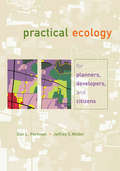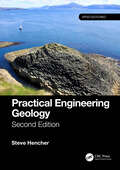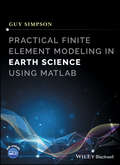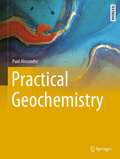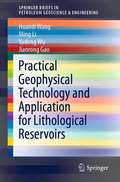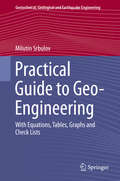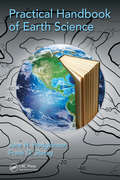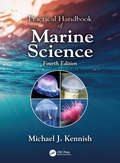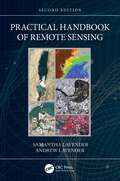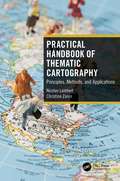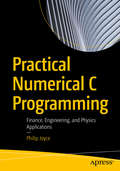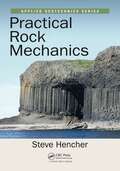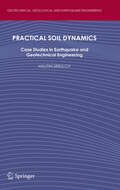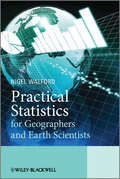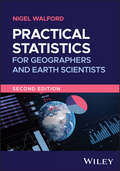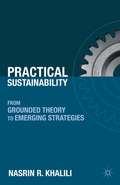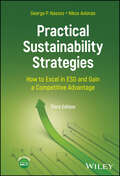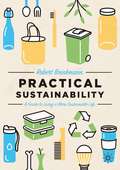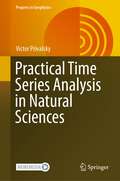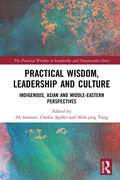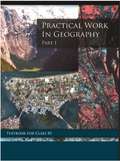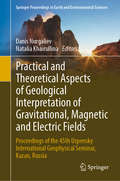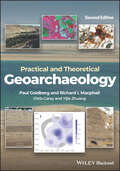- Table View
- List View
Practical Aspects of Computational Chemistry II
by Jerzy Leszczynski Manoj ShuklaPractical Aspects of Computational Chemistry II: An Overview of the Last Two Decades and Current Trends gathers the discussion of advances made within the last 20 years by well-known experts in the area of theoretical and computational chemistry and physics. The title reflects the celebration of the twentieth anniversary of the "Conference on Current Trends in Computational Chemistry (CCTCC)" to success of which all authors contributed. Starting with the recent development of modeling of solvation effect using the Polarizable Continuum Model (PCM) at the Coupled-Cluster level and the effects of extreme pressure on the molecular properties within the PCM framework, this volume focuses on the association/dissociation of ion pairs in binary solvent mixtures, application of graph theory to determine the all possible structures and temperature-dependent distribution of water cluster, generalized-ensemble algorithms for the complex molecular simulation, QM/MD based investigation of formation of different nanostructures under nonequilibrium conditions, quantum mechanical study of chemical reactivity of carbon nanotube, covalent functionalization of single walled-carbon nanotube, designing of functional materials, importance of long-range dispersion interaction to study nanomaterials, recent advances in QSPR/QSAR analysis of nitrocompounds, prediction of physico-chemical properties of energetic materials, electronic structure and properties of 3d transition metal dimers, the s-bond activation reactions by transition metal complexes, theoretical modeling of environmental mercury depletion reaction, organolithium chemistry and computational modeling of low-energy electron induced DNA damage. Practical Aspects of Computational Chemistry II: An Overview of the Last Two Decades and Current Trends is aimed at theoretical and computational chemists, physical chemists, materials scientists, and particularly those who are eager to apply computational chemistry methods to problems of chemical and physical importance. This book provides valuable information to undergraduate, graduate, and PhD students as well as to established researchers. Practical Aspects of Computational Chemistry II: An Overview of the Last Two Decades and Current Trends is aimed at theoretical and computational chemists, physical chemists, materials scientists, and particularly those who are eager to apply computational chemistry methods to problems of chemical and physical importance. This book provides valuable information to undergraduate, graduate, and PhD students as well as to established researchers.
Practical Ecology for Planners, Developers, and Citizens
by Dan L. Perlman Jeffrey MilderPractical Ecology for Planners, Developers, and Citizens introduces and explains key ecological concepts for planners, landscape architects, developers, and others involved in planning and building human habitats. The book is tailored to meet the needs of busy land use professionals and citizens seeking a concise yet thorough overview of ecology and its applications. It offers clear guidelines and a wealth of information on how we can protect species and ecosystems while at the same creating healthy, sustainable human communities. Throughout the book, the authors make ecological concepts accessible to readers with little or no scientific background. They present key ideas and information in simple and pragmatic terms, and provide numerous graphics to help explain important concepts. They also offer exercises for the reader to practice ecologically-based planning and design, along with a list of resources for practical information on ecology and conservation. Practical Ecology for Planners, Developers, and Citizens will raise the level of ecological understanding among land use professionals and citizens, and is an invaluable new resource for anyone concerned with human land use and its environmental impacts.
Practical Engineering Geology (Applied Geotechnics)
by Steve HencherPractical Engineering Geology provides an introduction to the way projects are managed, designed and constructed, and how the engineering geologist can contribute to cost- effective and safe project achievement. The need for a holistic view of geological materials, from soil to rock, and of geological history is emphasised. Chapters address key aspects of• Geology for engineering and ground modelling• Site investigation and testing of geological materials• Geotechnical parameters• Design of slopes, tunnels, foundations, and other engineering structures• Identifying hazards• Avoiding unexpected ground conditionsThis second edition includes a new chapter on environmental issues covering hydrogeology, considerations of climate change, earthquakes, and more. All chapters have been updated, with extensively revised figures throughout and several new case studies of unexpected ground conditions. The book will support practising engineering geologists and geotechnical engineers, as well as MSc level students of engineering geology and other geotechnical subjects.
Practical Finite Element Modeling in Earth Science using Matlab
by Guy SimpsonMathematical models have become a crucial way for the Earth scientist to understand and predict how our planet functions and evolves through time and space. The finite element method (FEM) is a remarkably flexible and powerful tool with enormous potential in the Earth Sciences. This pragmatic guide explores how a variety of different Earth science problems can be translated and solved with FEM, assuming only basic programming experience. This book begins with a general introduction to numerical modeling and includes multiple sample Matlab codes to illustrate how FEM is implemented in practice. Textboxes have been included to provide additional detail, such as specialized Matlab usage or advanced topics. Covering all the key aspects, this is essential reading for those looking to master the technique, as well as those simply seeking to increase their basic level of understanding and appreciation of FEM.
Practical Geochemistry (Springer Textbooks in Earth Sciences, Geography and Environment)
by Paul AlexandreThis book is a marked departure from typical introductory geochemistry books available: It provides a simple, straightforward, applied, and down-to-earth no-nonsense introduction to geochemistry. It is for the undergraduate students who are introduced to the subject for the first time, but also for practicing geologists who do not need the heavy-duty theory, but some clear, simple, and useful practical tips and pointers.This book, written from the point of view of a practicing geologist, introduces the fundamental and most relevant principles of geochemistry, explaining them whenever possible in plain terms. Crucially, this textbook covers – in a single volume! – practical and useful topics that other introductory geochemistry books ignore, such as sampling and sample treatment, analytical geochemistry, data treatment and geostatistics, classification and discrimination diagrams, geochemical exploration, and environmental geochemistry. The main strengths of this book are the breadth of useful and practical topics, the straightforward and approachable way in which it is written, the numerous real-world and specific geological examples, and the exercises and review questions (using real-world data and providing on-line answers). It is therefore easily understood by the beginner geochemist or any geologist who desires to use geochemistry in their daily work.
Practical Geophysical Technology and Application for Lithological Reservoirs (SpringerBriefs in Petroleum Geoscience & Engineering)
by Ming Li Huandi Wang Yadong Wu Jianrong GaoThis book introduces new geological analysis and geophysical methods and techniques for lithological reservoir exploration. It puts forward a set of practical geophysical methods and techniques aimed at lithological reservoirs in China. From a practical point of view, the book systematically analyses geophysical methods and technique principles, applied steps, key problems and caution notes in lithological exploration. The lessons of the book are demonstrated with a case study of the Songliao Basin, which has a large area with a low density of lithological reservoirs, indicating the methods and techniques that can identify lithological reservoirs. It is unique in its fusion of theory, method and technology and practice.
Practical Guide to Geo-Engineering
by Milutin SrbulovThis handy reference manual puts a wealth of ready-to-use information, data, and practical procedures within immediate reach of geo-engineers and technicians, whether they be in the field or office. It assembles and organizes the most-needed set of equations, tables, graphs and check-lists on six major subfields of geo-engineering: investigations, testing, properties, hazards, structures and works. This practical reference for the professional and others interested in the subject of ground engineering skips lengthy definitions to highlight best practice and methods proven most effective. While reflecting codes and standards, it also fills the gaps with non-standard approaches when existing ones are skimpy on practical details or agreement. Enhanced by 146 illustrations and 83 tables, the Practical Guide to Geo-Engineering points users to supporting information and data through its extensive reference list. Audience: This book is of interest to everyone involved in practical geo-engineering.
Practical Handbook of Earth Science
by Jane H. Hodgkinson Frank D. StaceyThis self-contained handbook provides a carefully researched, compact source of key earth science information and data, logically sorted by subject matter, and then cross-referenced. Appealing to both experts and non-experts alike, the book presents earth science and environmental science as closely intertwined. It includes tables of the global distributions of fossil fuels, contrasted by tables of the distribution of non-fossil energy sources. Concise explanations cover the subject matters of geology, geophysics, oceans, atmosphere with attention to environmental implications and resources.
Practical Handbook of Marine Science (CRC Marine Science #10)
by Michael J. KennishThe heavily-revised Practical Handbook of Marine Science, Fourth Edition continues its tradition as a state-of-the-art reference that updates the field of marine science to meet the interdisciplinary research needs of physical oceanographers, marine biologists, marine chemists, and marine geologists. This edition adds an entirely new section devoted to Climate Change and Climate Change Effects. It also adds new sections on Estuaries, Beaches, Barrier Islands, Shellfish, Macroalgae, Food Chains, Food Webs, Trophic Dynamics, System Productivity, Physical-Chemical-Biological Alteration, and Coastal Resource Management. The Handbook assembles an extensive international collection of marine science data throughout, with approximately 1,000 tables and illustrations. It provides comprehensive coverage of anthropogenic impacts in estuarine and marine ecosystems from local, regional, and global perspectives. Maintaining its user-friendly, multi-sectional format, this comprehensive resource will also be of value to undergraduate and graduate students, research scientists, administrators, and other professionals who deal with the management of marine resources. Now published in full color, the new edition offers extensive illustrative and tabular reference material covering all the major disciplines related to the sea.
Practical Handbook of Remote Sensing
by Samantha Lavender Andrew LavenderThe number of Earth observation satellites launched in recent years is growing exponentially, along with the datasets they gather from free-to-access and commercial providers. The second edition of Practical Handbook of Remote Sensing is updated with new explanations and practical examples using the Copernicus satellite data and new versions of the open-source software. A new chapter and new applications have also been added. Thoroughly revised, the handbook continues to be a practical "how-to" remote sensing guide for those who want to use the technology, understand what is available, how to access it, and answer questions about our planet, but do not necessarily want to become scientific experts.
Practical Handbook of Thematic Cartography: Principles, Methods, and Applications
by Nicolas Lambert Christine ZaninMaps are tools used to understand space, discover territories, communicate information, and explain the results of geographical analysis. This practical handbook is about thematic cartography. With more than 120 colorful amazing illustrations, numerous boxed texts, definitions, and helpful tools, this step-by-step introduction to cartography is both the art of understanding the world and a powerful tool for explaining it. Through many hands-on tests, the reader will learn how to produce an interesting and communicative map applied to any spatial theme. Written by experienced scholars and experts in cartography, this book is an excellent resource for undergraduate students and non-cartographers interested in designing, understanding, and interpreting maps. It includes practical exercises explained in the form of a game and provides a concise, accessible, and current address of cartographic principles, allowing readers to go deeper into cartographic design. It can be read from beginning to end like an essay or just by dipping into it for information as needed.
Practical Numerical C Programming: Finance, Engineering, and Physics Applications
by Philip JoyceMaster the C code appropriate for numerical methods and computational modeling, including syntax, loops, subroutines, and files. Then, this hands-on book dives into financial applications using regression models, product moment correlation coefficients, and asset pricing. Next, Practical Numerical C Programming covers applications for engineering/business such as supermarket stock reordering simulation as well as flight information boards at airports and controlling a power plant. Finally, the book concludes with some physics including building simulation models for energy and pendulum motion. Along the way, you’ll learn center-of-mass calculations, Brownian motion, and more. After reading and using this book, you'll come away with pragmatic case studies of actual applications using C code at work. Source code is freely available and includes the latest C20 standard release. What You Will Learn Apply regression techniques to find the pattern for depreciation of the value of cars over a period of years Work with the product moment correlation coefficient technique to illustrate the accuracy (or otherwise) of regression techniques Use the past stock values of an asset to predict what its future values may be using Monte Carlo methods Simulate the buying of supermarket stock by shoppers and check the remaining stock: if it is too low print a message to reorder the stock Create a file of arrivals for an airport and send data to the airport’s display boards to show the current situation for the incoming flights Simulate the patterns of particles moving in gases or solids Who This Book Is For Programmers and computational modelers with at least some prior experience with programming in C as well as programming in general.
Practical Rock Mechanics (Applied Geotechnics)
by Steve HencherThis text provides an introduction for graduate students, as well as engineering geologists and geotechnical engineers. It is also relevant to those working in nuclear waste disposal and oil and gas production. The early chapters deal with fundamental mechanics and physics as they apply to rock masses. It provides an introduction to the geological processes that give rise to the nature of rock masses and control their mechanical behavior. It discusses stresses in the earth's crust and explains methods of measurement and prediction.
Practical Seismic Data Analysis
by Hua-Wei ZhouThis modern introduction to seismic data processing in both exploration and global geophysics demonstrates practical applications through real data and tutorial examples. The underlying physics and mathematics of the various seismic analysis methods are presented, giving students an appreciation of their limitations and potential for creating models of the sub-surface. Designed for a one-semester course, this textbook discusses key techniques within the context of the world's ever increasing need for petroleum and mineral resources - equipping upper undergraduate and graduate students with the tools they need for a career in industry. Examples presented throughout the text allow students to compare different methods and can be demonstrated using the instructor's software of choice. Exercises at the end of sections enable students to check their understanding and put the theory into practice and are complemented by solutions for instructors and additional case study examples online to complete the learning package.
Practical Soil Dynamics
by Milutin SrbulovThe objective of this book is to fill some of the gaps in the existing engineering codes and standards related to soil dynamics, concerning issues in earthquake engineering and ground vibrations, by using formulas and hand calculators. The usefulness and accuracy of the simple analyses are demonstrated by their implementation to the case histories available in the literature. Ideally, the users of the volume will be able to comment on the analyses as well as provide more case histories of simple considerations by publishing their results in a number of international journals and conferences. The ultimate aim is to extend the existing codes and standards by adding new widely accepted analyses in engineering practice. The following topics have been considered in this volume: * main ground motion sources and properties * typical ground motions, recording, ground investigations and testing * soil properties used in simple analyses * fast sliding in non-liquefied soil * flow of liquefied sandy soil * massive retaining walls * slender retaining walls * shallow foundations * piled foundations * tunnels, vertical shafts and pipelines * ground vibration caused by industry. Audience: This book is of interest to geotechnical engineers, engineering geologists, earthquake engineers and students
Practical Statistics for Geographers and Earth Scientists
by Nigel WalfordPractical Statistics for Geographers and Earth Scientists provides an introductory guide to the principles and application of statistical analysis in context. This book helps students to gain the level of competence in statistical procedures necessary for independent investigations, field-work and other projects. The aim is to explain statistical techniques using data relating to relevant geographical, geospatial, earth and environmental science examples, employing graphics as well as mathematical notation for maximum clarity. Advice is given on asking the appropriate preliminary research questions to ensure that the correct data is collected for the chosen statistical analysis method. The book offers a practical guide to making the transition from understanding principles of spatial and non-spatial statistical techniques to planning a series analyses and generating results using statistical and spreadsheet computer software.Learning outcomes included in each chapterInternational focusExplains the underlying mathematical basis of spatial and non-spatial statisticsProvides an geographical, geospatial, earth and environmental science context for the use of statistical methodsWritten in an accessible, user-friendly styleDatasets available on accompanying website at www.wiley.com/go/Walford
Practical Statistics for Geographers and Earth Scientists
by Nigel WalfordA practice-oriented and accessible introduction to geographical statistics In the newly revised Second Edition of Practical Statistics for Geographers and Earth Scientists, distinguished researcher Nigel Walford delivers an authoritative and easy-to-follow introduction to the principles and applications of statistical analysis in a geographical context. The book assists students in the development of competence in the statistical procedures necessary to conduct independent investigations, field-work, and related geographical research projects. The book explains statistical techniques relevant to geographical, geospatial, earth, and environmental data. It employs graphics and mathematical notation for maximum clarity. Guidance is provided on how to formulate research questions to ensure that the correct data is collected for the chosen analysis method. This new edition incorporates a new section on exploratory spatial analysis and spatial statistics. It also offers: A thorough introduction to first principles in the statistical analysis of geographical data, including discussions of the quality, content, collection, and acquisition of geographical data In-depth treatments of geographical data exploration, including the taking of statistical measures or quantities, as well as frequency distributions, probability, and hypotheses Comprehensive explorations of testing times, including parametric and nonparametric tests Insightful discussions of relationship investigation, including correlation and regression, as well as the spatial aspects of geographical data Perfect for undergraduates pursuing a degree in geography, Practical Statistics for Geographers and Earth Scientists will also be a valuable tool for students in other earth and environmental sciences.
Practical Sustainability
by Nasrin R. KhaliliA structured guideline for development and implementation of business strategies, programs, and models with core sustainability values is then proposed and explicitly discussed, drawing upon management models, tools and techniques proven to be effective in organizational decision-making and prognostication.
Practical Sustainability Strategies: How to Excel in ESG and Gain a Competitive Advantage
by Nikos Avlonas George P. NassosA comprehensive guide for developing and implementing ESG strategies that propel sustainable growth and enhance corporate responsibility Practical Sustainability Strategies: How to Excel in ESG and Gain a Competitive Advantage provides the essential tools needed to implement ESG (Environmental, Social, and Governance) frameworks. With a strong focus on actionable strategies and practical applications, this real-world guide offers expert insights into how sustainability can drive corporate success while benefiting the environment and society. In-depth yet accessible chapters bridge the gap between theory and practice, arming readers with proven frameworks to align organizational goals with global sustainability standards. The book covers the latest ESG trends and includes real-world case studies to help readers navigate the evolving landscape. The updated and expanded third edition builds on previous insights by incorporating the latest trends, tools, and guidelines, including an entirely new chapter on ESG and circular economy, to ensure that businesses stay ahead of the curve. Laying out a clear path to building sustainable, competitive businesses, this book: Provides the tools and knowledge required to communicate, measure, and report ESG metricsEmpowers organizations to lead with transparency and accountability, positively impacting both their bottom line and the wider worldIncludes PowerPoint slides for instructors and trainers to facilitate effective teaching and learningAddresses both advanced and specialist levels, suitable for professionals and students at various stages in their careersContains numerous case studies and practical templates based on Global Reporting Initiative (GRI) Standards Ideal for graduate-level students studying sustainability, corporate social responsibility, business strategy, and corporate governance, Practical Sustainability Strategies: How to Excel in ESG and Gain a Competitive Advantage, Third Edition is also a valuable resource for C-Suite executives and sustainability managers, including Chief Sustainability Officers looking to deepen their knowledge and improve their organization’s ESG performance; as well as for government organizations and NGOs.
Practical Sustainability: A Guide to a More Sustainable Life
by Robert BrinkmannThis book will teach you everything you need to know about sustainable living—from reducing your greenhouse gas footprint to making sure that you are part of the green economy. Along the way, readers will learn about the field of sustainability and the “three E’s” of sustainable living—environment, economy, and equity. We are in the midst of great environmental change and all of us need to do everything we can to try to live more gently on the planet. Robert Brinkmann provides a range of options for readers as to what they can do to try to make a difference. Some involve simple lifestyle changes - but he also challenges all of us to commit to make more difficult and more meaningful changes to create a greener, more sustainable world. The book also delves into how we can create more sustainable communities, schools, and organizations. It showcases many examples of people and organizations that are making significant contributions to improving our planet’s sustainability that serve as inspiration and guidance for all of us trying to live more sustainably.
Practical Time Series Analysis in Natural Sciences (Progress in Geophysics)
by Victor PrivalskyThis book presents an easy-to-use tool for time series analysis and allows the user to concentrate upon studying time series properties rather than upon how to calculate the necessary estimates. The two attached programs provide, in one run of the program, a time and frequency domain description of scalar or multivariate time series approximated with a sequence of autoregressive models of increasing orders. The optimal orders are chosen by five order selection criteria. The results for scalar time series include time domain stochastic difference equations, spectral density estimates, predictability properties, and a forecast of scalar time series based upon the Kolmogorov-Wiener theory. For the bivariate and trivariate time series, the results contain a time domain description with multivariate stochastic difference equations, statistical predictability criterion, and information for calculating feedback and Granger causality properties in the bivariate case. The frequency domain information includes spectral densities, ordinary, multiple, and partial coherence functions, ordinary and multiple coherent spectra, gain, phase, and time lag factors. The programs seem to be unique and using them does not require professional knowledge of theory of random processes. The book contains many examples including three from engineering.
Practical Wisdom, Leadership and Culture: Indigenous, Asian and Middle-Eastern Perspectives (The Practical Wisdom in Leadership and Organization Series)
by Ali IntezariDespite the growing attention towards the importance of practical wisdom in business today, little research has been done about the concept of practical wisdom in the Indigenous, Asian and Middle-Eastern traditions. Contemporary studies of wisdom are dominated by the philosophical traditions of Western thought, which is based on the ancient Greek concepts of wisdom. Much less is known about how practical wisdom, as illuminated by these other traditions, can be implemented in today’s organizational settings. This book thus fills an important gap in understanding wisdom and how it is applied in a poly-cultural world. Wisdom is culturally bound. Wisdom is poly-cultural and interweaves individuality and communality. Practical wisdom is inextricably connected to many needs of contemporary personal and professional life. Moreover, the increasingly growing poly-culturality around the world requires a better understanding of how practical wisdom is understood in different cultures and traditions. Accordingly, there is a need for a) poly-cultural understanding of the concept of wisdom and b) the role of practical wisdom in a world crying out for wisdom. This book underlines the importance of developing a poly-cultural and interdisciplinary understanding of the concept of practical wisdom in today’s complex environment. The book offers significant insight into the implications of the non-Western traditions of wisdom and how such an understanding of the non-Western traditions can help us better and more critically understand and appropriately address new multi-faceted complex emerging phenomena. While the Western traditions offer valuable insight into the implication of wisdom in modern life, an integrated view that brings together the Western and non-Western traditions can provide a more critical and practical insight into how to apply practical wisdom in a contemporary poly-cultural environment.
Practical Work in Geography Part-1 class 11 - NCERT - 23
by National Council of Educational Research and TrainingThe 'Practical Work in Geography Part I' textbook, designed for Class XI students, is an introductory guide to the practical aspects of geography. It serves as a comprehensive manual that covers essential geographic tools and techniques. Readers are introduced to the fundamental concepts of cartography, including map reading, scale, and map projections. The book delves deep into the methodologies behind data collection, analysis, and interpretation in geographical research. Emphasis is placed on hands-on activities, promoting experiential learning through field surveys, data plotting, and graphical representation. Additionally, the textbook integrates thematic maps, diagrams, and illustrative examples to clarify complex geographical phenomena. By the end of the book, students are expected to be proficient in various practical skills that will prove invaluable in advanced geographic studies and real-world applications.
Practical and Theoretical Aspects of Geological Interpretation of Gravitational, Magnetic and Electric Fields: Proceedings Of The 45th Uspensky International Geophysical Seminar, Kazan, Russia (Springer Proceedings in Earth and Environmental Sciences)
by Danis Nurgaliev Natalia KhairullinaThis volume offers an overview of the state-of-the-art theoretical and practical approaches currently used for geophysical data interpretation. It includes new methods and techniques for solving data processing problems, and an analysis of geopotential fields by international researchers. It discusses topics such as: 1. Theoretical issues of interpretation of gravitational, magnetic and electric fields, including general methods of interpreting potential fields and other geophysical data. 2. Modern algorithms and computer technologies for interpretating geophysical fields. 3. The study of Earth deep structure using terrestrial and satellite potential field anomalies. 4. Geological interpretation of gravitational, magnetic and electric fields. This proceedings book is of interest to all geophysical researchers.
Practical and Theoretical Geoarchaeology
by Paul Goldberg Richard I. Macphail Chris Carey Yijie ZhuangPractical and Theoretical Geoarchaeology, Second Edition, provides an invaluable and vastly updated overview of geoarchaeology and how it can be used effectively in the study of archaeological sites and contexts. Taking a pragmatic and functional approach, this book presents: a fundamental, broad-based perspective of the essentials of modern geoarchaeology in order to demonstrate the breadth of the approaches and the depth of the problems that it can tackle. the rapid advances made in the area in recent years, but also gives the reader a firm grasp of conventional approaches. covers traditional topics with the emphasis on landscapes, as well as anthropogenic deposits and site formation processes and their investigation. provides guidelines for the presentation of field and laboratory methods and the reporting of geoarchaeological results. essential reading for archaeology undergraduate and graduate students, practicing archaeologists and geoscientists who need to understand and apply geoarchaeological methodologies, and help foster the dialog among diverse researchers investigating archaeological sites. Practical and Theoretical Geoarchaeology, Second Edition, is an ideal resource for undergraduate and graduate students in archaeology, and a great practical reference for practicing archaeologists and geoscientists who need to understand and apply geoarchaeological methodologies internationally.

